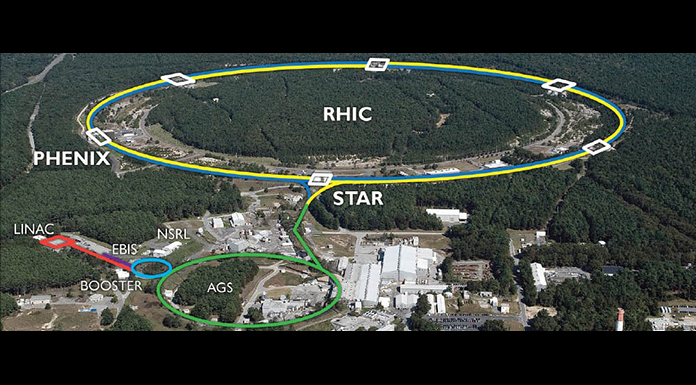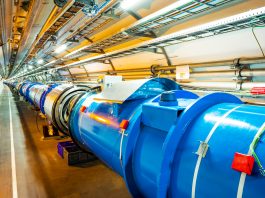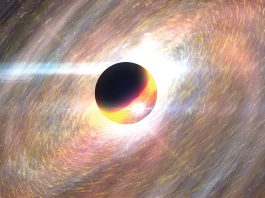Professor John W Harris, from Yale University’s Wright Laboratory, outlines the development of accelerator technologies and the evolution in relativistic heavy ion collider physics research we have seen along with it.
The field of relativistic heavy ion physics seeks to create and investigate matter that existed around 10 microseconds after the Big Bang. At that time, all matter in the Universe was at a temperature 200,000 times hotter than the centre of the Sun and in the form of a hot soup of quarks and gluons, called the quark-gluon plasma (QGP). As the Universe cooled, the matter experienced a phase transition from this soup into individual particles, akin to water freezing to ice crystals when it cools. Today, under the much cooler conditions in the Universe, quarks and gluons are found to be the primary constituents of nuclear particles, for example in the protons and neutrons that form the nuclei at the centre of all atoms.
Relativistic heavy ion physics research has recently entered a new era, that of collider physics. Previously, heavy ion physics research took place at fixed-target accelerators, where nuclear beams bombarded targets at a number of laboratories worldwide. In the year 2000, the Relativistic Heavy Ion Collider (RHIC) began operation in the United States and in 2010 the Large Hadron Collider (LHC) was turned on in Europe. These colliders accelerate and collide beams of nuclei at much higher energies, allowing the creation of matter at temperatures sufficient to form the QGP.
The experiments performed at these colliders have uncovered a new realm of physics in their exploration of the QGP. The experiments consist of very complex detector systems which are able to detect the telltale signs of matter at the high temperatures that form a QGP. The nuclei collide at very near the speed of light. In such violent collisions, the energy of the colliding nuclei heats up the system to incredibly high temperatures (2 x1012 Kelvin) for a very short instant of time (10-23 seconds). Measuring the products of these collisions allows us to essentially go back in time and to trace and study matter under the extreme conditions that existed only shortly after the Big Bang. Such collisions create up to tens of thousands of matter particles, anti-matter particles, and photons of light carrying energy. Advances in instrumentation have been necessary for these experiments to detect, accumulate, transfer, and record data at the high rates important for precision studies. Furthermore, new technologies will be necessary to continue these discoveries into the future and understand the nature of their novel phenomena.
Thus far, we have verified the creation of such a hot liquid with the properties of a QGP. It is the hottest liquid in Nature. It is much less viscous than water, approaching the theoretically lowest possible value, and flows more easily than anything known to man. A continuing goal of the field is to precisely determine additional properties of the QGP through experiments that are continually upgraded to utilise and keep up with developments in detector, electronic, and computing technologies. Progress in understanding the physics and properties of this unique form of matter are dependent upon close collaboration among experimental physicists as well as keeping up with the progress of theoreticians whose capabilities are also improved continually by advances in computing.
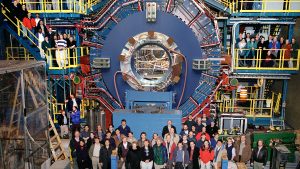
Heavy Ion Colliders and Experiments – the Relativistic Heavy Ion Collider (RHIC)
The Relativistic Heavy Ion Collider (RHIC) was identified initially by the US Nuclear Science Advisory Committee (NSAC) in 1983 as the highest priority for a new facility for high energy nuclear physics research. After reaffirmation and strong endorsement by NSAC in 1989 and approval for construction in 1990, RHIC began operation with four detector systems in 2000. An aerial view of RHIC with its pre-accelerator complex and the two largest experiments (PHENIX and STAR) is shown in fig. 1, with a colour overlay of its layout. Nuclear beams from hydrogen to uranium are accelerated in a linear accelerator (LINAC), energy booster ring (Booster), and alternating gradient synchrotron accelerator (AGS). They are then injected into the two 3.8km RHIC rings, accelerated in opposite directions and collided at the centres of the complex detectors systems. The maximum energy of A+A collisions in the centre-of-mass of the colliding system is A x 200GeV, where A is the atomic number of the colliding nuclei and 1GeV is slightly more than the rest energy of a proton. RHIC has exhibited its unique flexibility to accelerate and collide nuclear beams over a broad range of atomic nuclei and beam energies, including very low energies to investigate the phase transition from the QGP to normal matter. New cooling techniques were developed to maintain sufficiently compact beam dimensions for low energy operation of RHIC.
Like every major construction project in physics, RHIC first undertook a robust research and development (R&D) programme. That programme focused mainly on development of the superconducting magnets (3.5T operating values, with quench protection to 4.5T) for the two RHIC rings. It also included the specific issues of developing an ion source for very heavy ions, ion transport, injection into the collider, and colliding the two counter-circulating beams in the centre of the detector regions. Of the required 1,740 superconducting magnets for RHIC, 1,140 units were manufactured by industry. Beams were injected, accelerated and stored in RHIC using one radio frequency system at 28MHz to capture the AGS bunches and accelerate in RHIC, and another of the magnets at 197MHz to provide a short intersection diamond (~25cm) inside the detectors. Cryogenic cooling of the magnets to between 4.3 and 4.6K was required and a vacuum of 10-10 Torr or better inside the RHIC rings maintained. The beams were collided in the centres of the experiments and longitudinal stochastic cooling was implemented to reduce the energy spread and beam losses, and to shorten the interaction region to maintain higher luminosities.
Relativistic Heavy Ion Collider Detectors
RHIC construction began in 1991, and within a couple of years four detector systems were approved for construction and installation. These consisted of two major multi-purpose detector systems (STAR and PHENIX) and two smaller specialised systems (PHOBOS and BRAHMS).1 All detector systems at RHIC started data-taking in 2000. The PHOBOS, BRAHMS and PHENIX detectors completed operation in 2005, 2006, and 2016, respectively. STAR continues to operate. A new high rate detector system, sPHENIX, is being constructed and will become operational in 2023.
The STAR experiment is embedded in a large solenoidal magnet as seen in fig. 2 and focuses on detecting and identifying hadrons, high momentum particles and jets over a large acceptance. It also measures electrons and has upgraded to measure muons. PHENIX, with an axial field magnet and two detector arms, was designed to measure electrons, muons, and photons, while also detecting hadrons. The BRAHMS detector was a movable conventional two-arm spectrometer system measuring momenta and identifying hadrons over a variety of settings throughout a large kinematic range. PHOBOS was also a two-arm spectrometer system, but with large acceptance and fast electronics for high data rate capabilities.
A detector R&D programme was undertaken to develop detectors and electronics capable of efficiently accumulating the large amount of data from collisions at RHIC.2 To accomplish this, one of the highest priorities for the RHIC detectors was the development of fast, high density, monolithic readout VLSI electronic circuits with large numbers of channels and a goal of low cost per channel. In addition, the readout electronics needed to amplify, store, and digitise the analogue signals onboard the detectors thus requiring low power due to restricted cooling and material limitations in the detectors.
Another critical goal of the detector R&D programme was to develop new detector technologies and data-handling techniques to be able to identify and measure the energy or momentum of the various types of particles from the collisions. These included neutral particles, in particular photons, as well as charged particles such as electrons, muons, and hadrons. In addition, secondary decays from displaced interactions required precision tracking of the primary interaction point and locations of secondary interactions. Furthermore, in collider experiments there are always size, density, and mass constraints in general for detectors and their readout electronics, especially near the interaction point.
The RHIC detector R&D programme produced significant advances in a number of different detector technologies. Advances were made by the heavy ion community in the development of fast high-track-density time-of-flight (ToF) detectors leading to the eventual use of resistive plate chambers for ToF detectors at RHIC. Compact silicon drift detectors were developed for low-cost three-dimensional silicon tracking near the interaction point and installed at RHIC. Zero-degree hadronic calorimeters were developed for each RHIC experiment for normalisation of results between experiments. This required specialised mechanical and calorimeter design engineering to fit into the 10cm wide space between the diverging RHIC beamlines. The investigation of high resolution electromagnetic calorimetry using CsI and PbF2 was undertaken. Additional developments and prototyping involved readout of ring imaging Cherenkov detectors, various types of muon identification detectors placed behind calorimetry or magnets, and a double-sided readout silicon-detector for particle multiplicities.
In the overall design of the detector systems, additional general and often mutual issues needed to be addressed. The large number of particles produced in collisions at RHIC strongly influenced the design, segmentation, and technology choices for the experiments. Careful attention was paid to detector performance in terms of efficiency and resolution for tracking, and the identification of particles in large acceptance detectors. Large event sizes required advances in online and offline trigger processing and high data volume transfer and storage. Various new computing techniques were investigated, such as neurocomputing for pattern recognition and tracking in events. FPGAs were further developed and utilised for flexibility of function in circuits with large numbers of gates in some of the experiments. There were significant advances in analogue memory chips in general and specifically the development of a switched capacitor array for analogue storage of time projection chamber (TPC) data. CMOS ASIC chips were developed for transition radiation tracker readout.
An essential part of the success of the RHIC experimental programme has been the computing facility, which receives data from the experiments over fibre optics and stores it at unprecedented rates. Currently, with only the STAR experiment taking data, the data transfer rate is 40Gb/s. In 2023, when the sPHENIX experiment comes online, the data rate will increase to 200Gb/s. STAR and PHENIX utilise around 20PB of disk space and 108PB tape storage. About 33,000 cores of CPU are dedicated to the data processing for the two experiments. Once sPHENIX starts collecting data, these numbers are expected to increase to ~60PB of disk space, 500PB of tape storage and ~200,000 CPU cores.
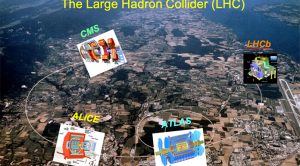
The Large Hadron Collider – LHC
The Large Hadron Collider (LHC) project3 was approved by the CERN Council in 1994 to investigate the Standard Model and new physics beyond the Standard Model with proton-proton collisions at unprecedented centre-of-mass energies up to 14TeV. It commenced operation in 2008, with first collisions in 2010. The Higgs Boson was discovered shortly afterwards in 2012. Along with the proton-proton collisions, the LHC was designed to collide heavy ions. Lead(Pb)-ions are currently collided at 5.2TeV centre-of-mass energy.
An aerial view of the LHC overlaid with its underground ring and symbols for each of its four experiments is shown in fig. 3. The LHC relies on a complex of individual accelerator facilities to produce, accelerate and prepare protons and ions for injection into the LHC, where it is then accelerated to the highest energies. The protons originate from hydrogen gas that is stripped and accelerated to 50MeV in Linac 2. They are then injected into the Proton Synchrotron Booster (accelerated to 1.4GeV), injected and accelerated in the Proton Synchrotron (PS) to 25GeV and finally the Super Proton Synchrotron (SPS) where they are accelerated to 450GeV. They are then transferred into the two rings of the LHC, one clockwise and the other counter-clockwise.
The LHC twin-bore superconducting magnet scheme was designed specifically for its installation into the existing LEP tunnel. It is 26.7km in circumference, 45-170m underground, and twice crosses the border between Switzerland and France. LHC’s magnets are cooled to below 2K using superfluid helium and operate at field strengths above 8T. The overall beam transport systems include 1,232 dipole magnets to bend the beams, each 15 meters in length, and 392 quadrupole magnets of 5-7 meters in length for beam focusing. Two independent 400MHz radio frequency systems are used to accelerate the beams in a vacuum of 10-11-10-10 Torr in counter-circulating directions in the tunnel. It takes about 25 minutes to ramp up the beams to the current energy of 6.5TeV per beam, the beam lifetime lasting many hours before refilling the rings. They are then collided with a total energy of 13TeV in the centres of each of the four detectors – ALICE, ATLAS, CMS, and LHCb. CERN, along with international laboratories and industrial partners, collaborated to design and construct the many components of the LHC.
The LHC was designed to facilitate a heavy ion research programme in addition to elementary particle physics with proton beams investigating the Standard Model and beyond. The main goal of the LHC heavy ion programme is to utilise a new generation of detector systems to further characterize properties of the QGP at a much higher energy than at RHIC. The expected larger energy density and increased yield of hard scattering probes at the LHC provide a longer-lived QGP, at higher temperatures, and extending over a larger volume than at RHIC. Not only does the system have some different characteristics, but also the new detector technologies allow for higher precision studies and the possibility to discover new features of the QGP formed at the LHC.
In order to collide heavy ions in the LHC, a complex injection chain accelerates the ions prior to insertion into the PS, SPS, and then into the LHC ring. The ions are created in an electron cyclotron resonance source (ECR), injected into a radio frequency quadrupole (RFQ) linear accelerator, followed by a special Linac 3 for heavy ions, and finally accumulated in the Low Energy Ion Ring (LEIR). Then they are injected into the PS and from there follow the same scheme for protons described above. Thus far, the LHC has collided beams of protons (p), and nuclei of Lead (Pb) and Xenon (Xe). Pb+Pb have been collided at beam energies of 5.02TeV (per proton and neutron in Pb) resulting in Pb+Pb collisions at a total centre-of-mass energy of 2.09PeV.
Asymmetric collisions of p+Pb at the LHC were also achieved after several technical developments. Asymmetric collisions are unlike symmetric collisions in that the different beam species (p, Pb) have different charge-to-mass ratios and cannot be accelerated to the same beam energy in the two-in-one ring design of the LHC. The magnet rigidities in the LHC must be the same in order for the different counter-circulating beams to be held in stable orbits in a single ring. They must then have different revolution frequencies and still collide at the centres of each of the detectors. For example, the Pb beams circulate several times fewer per minute in the LHC ring than protons.
The LHC Detectors for Heavy Ions
The LHC and its four major detector systems, ALICE, ATLAS, CMS, and LHCb, extend the frontiers of particle physics with the highest energies and luminosities. ATLAS and CMS were constructed to search for the Standard Model Higgs boson, which they have discovered, investigate Higgs decays, search for new heavy gauge bosons, and extend their investigations into physics beyond the Standard Model. The latter includes searches for decays of supersymmetric particles and the possible existence of extra dimensions, to name a few. LHCb is a specialised detector system that investigates new physics in charge-parity violation and rare decays of beauty and charm hadrons. These three experiments are also involved in the LHC heavy ion programme.
Perhaps the most widely utilised technological effort that benefitted all of the LHC experiments was an R&D programme to develop silicon micropattern detectors, which started about ten years prior to LHC start up. The fully depleted sensors made of high resistivity material allow the charge deposited by charged particles to be collected within the 50ns bunch crossing of the LHC. By start up in 2008, CMS, ATLAS, and ALICE had implemented 80M, 66M, and 10M pixels in their tracking systems. Silicon sensors are bump-bonded to ASICs and mounted on high density interconnects. Sensor design and readout is typically experiment specific and industry plays a major role in the sensor development and production. Typical readout channels consist of hundreds of transistors. Furthermore, as silicon wafer technology continues to evolve to higher electronic packing densities on thinner devices and more radiation-hard devices, the experiments continue to upgrade their tracking systems to take advantage of new developments that allow faster data rates and higher bandwidths.
The ALICE detector system was specifically designed and constructed to be the dedicated heavy ion experiment for the LHC. It is thus a general-purpose detector system capable of carrying out a broad range of measurements. The ALICE detectors are installed in a large solenoidal magnet. They are able to measure the trajectories (and thus the momenta in the magnetic field) of charged particles in six layers of silicon pixel, drift and strip detectors and a large TPC providing 3-D tracking with particle identification (PID) capabilities. Three more specialised PID detectors operate on the principles of the time-of-flight of particles, emission of Cherenkov light and transition radiation. There are also two detectors for electromagnetic radiation, a forward muon tracking and triggering system embedded in a dipole magnet, several detectors forward and at small angles for triggering and collision event characterisation, and a detector system outside the magnet for triggering on and monitoring cosmic rays. A view of ALICE during detector installation is shown in fig. 4.
In order to meet the requirements of ALICE for PID, an extensive R&D effort was started in the early 1990s. After various technologies were investigated and prototyped, ALICE implemented a double-stack Multigap Resistive Plate Chamber (MRPC) for a Time-of-Flight (ToF) detector with high uniformity of response, high efficiency (>99%), good time resolution (<50ps) and sufficiently low occupancy (<15%). It covers 160m2 with 160,000 pads each having an active area of 2.5×3.7cm2. The design consists of multiple layers of rigid and thin (400μm) glass with a thin resistive coating. High voltage (13.5kV) is applied across small gaps (250μm) between glass layers in a composite gas mixture (mainly C2F4H2) to create timing signals from charged particles. This technology was also employed in an upgrade of STAR and is the current choice for ToF in future heavy ion detector systems.
An R&D effort was undertaken to extend the range of PID in ALICE to momenta above 2GeV/c. A CsI Ring Imaging Cherenkov (RICH) detector system for particles with 1-5GeV/c was developed and tested. A large area (64x40cm2) CsI photocathode was developed with quantum efficiency exceeding 20% at 170nm. Two ASIC chips, one analogue and one digital, were developed for the front-end electronics of the RICH. A prototype was installed and operated successfully in STAR prior to LHC start up. As a result of another R&D effort to identify and develop scintillators and scintillating glasses for LHC detectors, Lead tungstate (PbWO4) was found to be a cost effective approach for a high resolution photon detector resulting in 17,920 modules installed in ALICE.
There are general technical issues associated with all collider experiments beyond the R&D and detector construction. These are primarily based on the need to integrate many different detector systems into one large experiment. They involve mechanical engineering to design systems that can be installed, fit together, and operate without interference; electrical engineering, for example power and cooling to efficiently remove the heat generated by the electronics onboard the detector; and electronic engineering to develop specialised low-mass, radiation-resistant readout chips and fibre optics for each detector subsystem. As the data is being accumulated it must be monitored, moved off the detectors at high rates, and stored for offline data analysis. The high data acquisition rates continually push the bandwidth limits of data transmission. Thus, state-of-the-art high performance data storage and GRID computing with scalable architectures are required in order for the data to be analysed and transformed into scientific results.
Relativistic Heavy Ion Near-term Detector Upgrades
CERN detector upgrades
The LHC will receive an upgrade resulting in 5-10 times higher luminosities. It will become the High-Luminosity LHC (HL-LHC) and commence operation in late 2027. The resultant higher interaction rates will allow deeper investigation into rare processes and will require significant detector development and upgrades. More highly segmented, faster radiation-hard detectors are being developed and will be installed in the detector systems in long shutdown 3 (LS3) in 2025-2027.
The LHC facility is currently in a long shutdown (LS2) until mid-2021 for upgrades of detector systems. Some of these are aimed at HL-LHC, while most are the replacement of important electronics and the maintenance of detector components. Some new electronics, trigger, and detector components are also being installed in LS2 for HL-LHC.
Higher luminosities are anticipated for heavy ions when the LHC restarts in 2021. To accommodate the higher interaction rates, ALICE is implementing a major upgrade of its detectors, triggering, data-acquisition, and data-processing systems. A seven-layer silicon-pixel detector based on a new compact CMOS monolithic active pixel sensor (MAPS) is being installed. Both the sensor for charge collection and the readout circuit for digitisation are on the same silicon chip, thus dispensing with tedious bump-bonding. This technology allows for much higher spatial resolution and is also being employed in the ALICE muon forward tracker close to the beam pipe. Another major upgrade to ALICE is replacement of all TPC conventional multi-wire proportional readout chambers with new multi-stage gas electron multiplier (GEM) chambers in order to increase its data rates by two orders of magnitude.
LHCb is installing fast electronics to increase its readout rate and is improving its triggering and computing power for event selection. A new ring-imaging Cherenkov (RICH) detector mirror system is being implemented to take data in much larger particle densities. It is also installing a new innovative tracking station with silicon-microstrip sensors and three with scintillating fibres read out by silicon photomultiplier arrays.
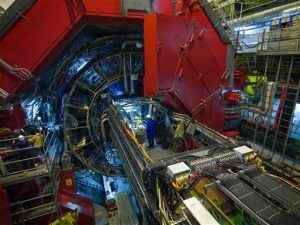
RHIC detector upgrades
The STAR detector at RHIC has been significantly upgraded to carry out its current programme that explores a possible critical point in the QCD phase diagram at lower beam energies. Detector upgrades include new inner-sector readout chambers for the TPC and an endcap ToF detector to extend its coverage and improve PID in the forward direction. STAR has also installed a new event plane detector for better event characterisation and plans on completing its low energy heavy-ion beam-scan programme in 2021. It will be upgraded with tracking and calorimetry in the forward direction to measure jets in 2022 to investigate the spin content of the proton in polarised p+p interactions and nuclear parton distribution functions at low x in proton+nucleus collisions. A new detector called sPHENIX is being constructed and will be installed at RHIC in 2023 with the goal of providing complementary information at lower energies to that of the LHC. It is a large acceptance detector system with particle tracking, hadronic and electromagnetic calorimetry aimed at high-rate measurements of jets and quarkonia.
Summary
I have attempted to demonstrate that the pursuit of knowledge in general breeds new ideas that lead to development of innovative techniques and pioneering instrumentation for discovery. New experiments are proposed and designed, ongoing experiments upgraded, all utilising the latest technological developments to increase measurement capabilities and precision. This in turn stimulates technological innovation and development for future generations of inquiry and exploration. The relativistic heavy ion collider program has benefited tremendously from instrumentation developments in nuclear and particle physics,* and continues to thrust the envelope of innovation forward. Prospects for future development will be the focus of a forthcoming article in The Innovation Platform.
* The tremendous evolution in microelectronics, high bandwidth data transfer, data storage and computing have also transferred into the popular realm leading to the development of microchips for compact electronics and computers, digital imaging, broadband communications, cell phone technology, and the world wide web, to name a few.
Acknowledgements
The author thanks A. Drees, E. Lancon and J. Schukraft for discussions on aspects of this article. This work was supported in part by the Office of Nuclear Physics of the U.S. Department of Energy.
References
- “The Relativistic Heavy Ion Collider Project: RHIC and its Detectors,” Editors: M. Harrison, T. Ludlam, S. Ozaki, NIMA in Physics Research Volume 499 (2003), p. 235-880
- See “Proceedings of the Symposium on RHIC Detector R&D,” October 10-11, 1991, Eds. Y. Makdisi and A. Stevens, BNL Report 52321, Brookhaven National Laboratory
- The CERN Large Hadron Collider: Accelerator and Experiments, 2008 JINST 3 S08001 through S08007
Prof John W Harris
Wright Laboratory
Yale University
+1 203 432 6106
john.harris@yale.edu
https://wlab.yale.edu
https://star.physics.yale.edu/johnharris
Please note, this article will also appear in the second edition of our new quarterly publication.

